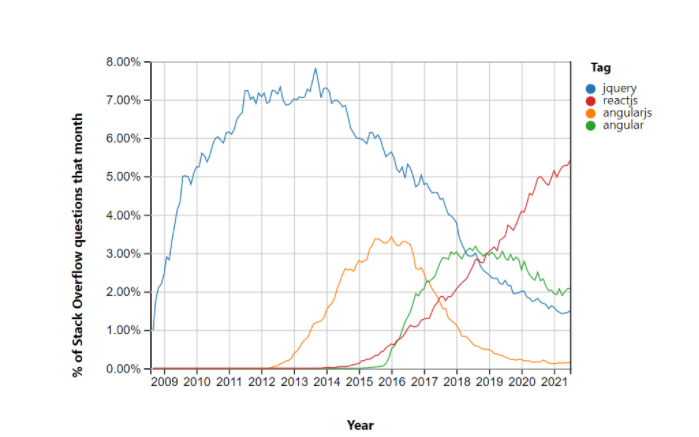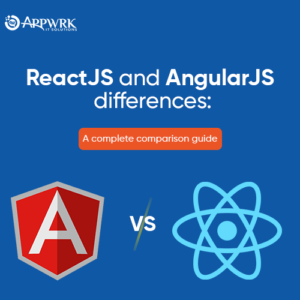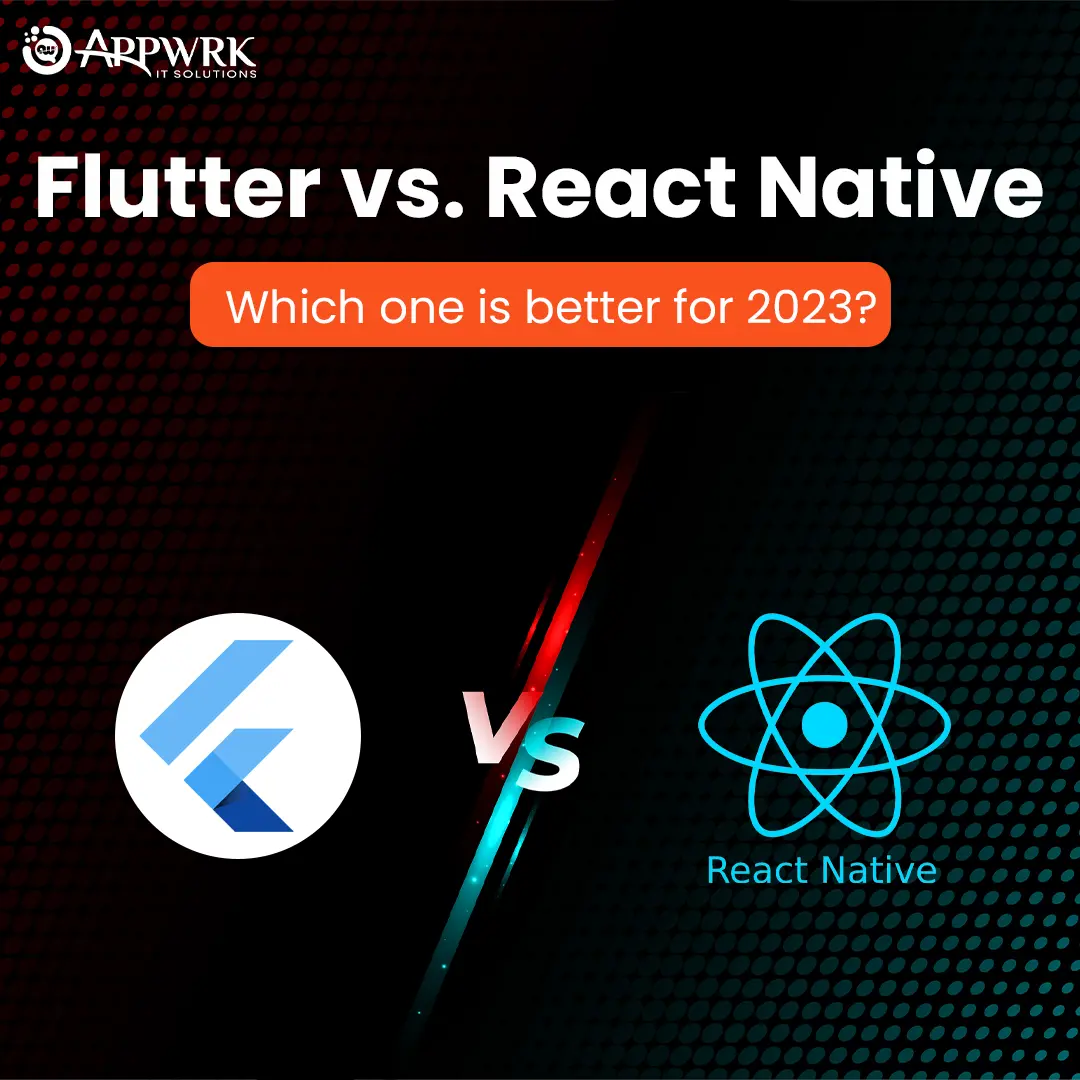Must know ReactJS and Angularjs differences
Every business desires to build a robust and scalable web application using the feature-rich, fully loaded framework as fast as possible. AngularJS and ReactJS are the two most popular frameworks if you are using JavaScript to build an application. Which one to choose may leave you in a severe dilemma. This article will help you to arrive at the best decision. It covers the ReactJS and AngularJS differences from popularity, technical, and operational point of view.
The requirement of front-end development frameworks and libraries has increased productively over the past few years. Out of all the Progressive Web App, React, and Angular are the most used frameworks among web development companies. Angular with the two-way data binding always ensures that data is in sync at all levels, while React has a shooter ramp-up time due to its easy learning curve. Both these frameworks come with their own benefits so deciding which will go best for your enterprise is quite tricky. This article provides comprehensive ReactJS and AngularJS differences, read it entirely, and then decide.
Refer to the below table for a quick look at ReactJS and AngularJS differences.
ReactJS VS AngularJS
What is ReactJS and its history?
ReactJS is also known as React or React.js. It is an open-source front-end JavaScript library for creating User Interfaces (UI). It is used as a base in the development of single-page or mobile applications. More precisely, we can say that it is used for software development solutions that constantly refresh data on its UI. React, being a JavaScript library, is used to create, use, and store JavaScript applications. Hence, in ReactJS, you don’t need to write the same script repeatedly; just pick what you need and add it directly to the code. You can consider ReactJS as a tree with multiple branches called components, and each component is a mixture of HTML and JavaScript. These components hold the logic required to display each section of a large UI. React is only concerned with the state management and providing that state to the DOM. Instead of changing the whole tree, in React, only the component whose value changes will update. There are various competitive advantages of ReactJS; hence without any doubt, with a ReactJS developer’s help, you can achieve more robust, scalable, and faster applications for your enterprise.
Check out the below table to discover the history and evolution of ReactJS over the years.
History of ReactJS
What is AngularJS and its history?
AngularJS is an open-source front-end framework for developing single-page applications. Google and a community of individuals maintain it. It simplifies the development and testing of applications by providing a framework for the client-side (MVC – Model, View, Controller) along with components commonly used in web applications and Progressive Web Applications. It is one of the famous and efficient Java frameworks. It is a structural framework designed to simplify the front-end development of websites. In AngularJS, you can use HTML as a template language. Although HTML is not efficient for applications, AngularJS extends the capability of HTML and allows you to modify different elements of the web page.
Check out the history and evolution of AngularJS over the years in the below table.
History of AngularJS
ReactJS and AngularJS differences
First, go through this summarised table to get an overview of both frameworks. It will help you to connect in a better way.
Let’s begin the battle between the two most popular frameworks, based on the following parameters:
1.Popularity ReactJS and Angularjs
- Google Trends
Google trends depict which framework is most talked about these days. Look at the given below google trends graph, which clearly shows that people are more interested in ReactJS, while AngularJS popularity has declined over time.


- Stack Overflow
React continues to gain popularity, while Angular has been in fame until the year 2016. Below given graph of Stack overflow shows that AngularJS and ReactJS are equally popular among the developers during 2017-2018. After that, ReactJS gained more users and became the most popular JavaScript library. In 2020 React became the most famous framework and stood at 1st position, while Angular stood at 4th position. According to the Stack Overflow developers survey, they would like to work on ReactJS rather than AngularJS.

- Statista
According to the survey of Statista, out of the most used frameworks among developers globally in 2021, ReactJS stood first (40.14% of software developers reported to be using ReactJS) while AngularJS stood forth in position.

- NPM downloads
The enhanced popularity of ReactJS makes it the most downloaded framework on NPM. Check out the below graph, which shows that ReactJS is five-time more downloaded than AngularJS. It is seen that the popularity of ReactJS has been rising over time.

2. Features of ReactJS vs AngularJS
Top 10 Features of ReactJS
1. JSX- JSX is one of the best features of ReactJS. It is a markup syntax that resembles HTML closely. It is a combination of JavaScript and XML. It makes it easier to write React components which are the building blocks of React UI. JSX makes the syntax identical to HTML, which developers insert into the webpage. Hence it avoids rewriting the same code again and again and saves time for ReactJS developers.
2. Virtual DOM- As the name implies, it makes a copy of the original DOM. Whenever any data is input by the user, the virtual DOM renders changes to the actual DOM. By comparing both DOM (virtual and real), only the changes in the component, which is changed, are rendered to the DOM. It means only the part of the DOM changed after user input is updated instead of the whole DOM. Virtual DOM makes applications faster and more scalable.
3. Declarative- ReactJS builds a very dynamic and interactive UI for web and mobile applications using declarative codes. We convey to JavaScript what we want to do with declarative codes and let the JavaScript perform all the steps to achieve our desired results. The declarative view makes our code easy to debug and more readable.
4. Event handling- Whenever an event is fired, event handlers determine what action is to be taken. ReactJS builds its own event system, which is compatible with the W3C object model. The React event system is conducted through event delegation, and to reduce memory overhead, it also comes with a pool of event objects.
5. Performance- ReactJS application performance is very high. Various factors result in high performance. Out of them, first is the Virtual DOM, with its help only that part of the DOM where component changes are updated instead of the entire DOM. Secondly, React uses one-way data binding along with application architecture- “Flux controls”. It updates the view for the user and, with the help of Flux, manages the application workflow. All these lead to less development time and high performance.
6. React Native- Like React DOM on the web, React Native is a custom renderer for React. React Native allows you to create natively rendered mobile applications for Android and iOS.
7. Component-Based- React is a tree of components. Every part of the application is wrapped inside a self-contained module called a component. These components are used to define the interaction and visuals in applications. Hence you can easily pass rich data through the applications and keep the state out of the DOM.
8. Server-side Rendering- It is one of the crucial features of ReactJS. ReactJS without waiting for all the JavaScript to be executed and stacked permits the browser to render. It means ReactJS allows pre-rendering the underlying state of React Component only on the server-side. Hence we can say that server-side rendering helps the page to stack faster.
9. Data binding- Data Binding is how properties are communicated to a component in ReactJS from a parent component. ReactJS offers one-way data binding. It means it follows the information in a single direction compared to two-way data binding, one-way help in simply understanding the code.
10. Stability- ReactJS is a stable core. You can easily make changes in the child’s structure without affecting the parent’s structure. Whenever developers want to change any object, they just have to alter the state to make modifications and simply update the changes.
Top 10 Features of AngularJS
1. Architecture- Angular application is created using Model view and controller (MVC) architecture. As per the components of MVC architecture, it separates the application into three parts- Model, View, and Controller. In AngularJS, applications are managed very fluently, as the logic and data parts are split into separate sections.
2. Data Binding- Angular offers two-way data binding. It means it allows bidirectional data flow with the help of specific template syntaxes. We don’t need to write separate code in Angular applications to perform the data binding functionality. We can easily bind data from HTML code to application data by just adding some snippets of codes.
3. Directives- AngularJS directives provide additional functionality to our Angular applications. These directives allow transforming the DOM element and its children. Angular also provides a way to build custom directives. The list of AngularJS directives- Complete list of directives
4. Code Less- With the help of ‘Filters’, the AngularJS codes are written less and do more type. In other words, developers can perform the same functionality with the same codes. There are various filters in AngularJS, such as currency, uppercase, lowercase, etc.
5. Speed and Performance- There are three reasons the speed and performance of Angular are faster, those are:
- Code Generation- While writing codes in Angular, it converts your template into optimized code. This provides you with the benefit of handwritten code along with the productivity of the framework.
- Code Splitting- The new component router of Angular comes with the ability of automatic code splitting. Due to this only the code requested to render the view is loaded.
- Universal- The first view of the application on other servers like node.js, PHP,.net, etc., is dependent on HTML CSS for their front-end server using Angular.
6. Not browser-specific- There are no browser constraints on AngularJS applications; they are not browser-specific. AngularJS applications can run on all browsers, except Internet Explorer 8.0.
7. Dependency Injection- Dependency injection helps an application to test efficiently. It is effortless to understand and helps develop applications quickly. It first asks for your dependencies rather than start making it by yourself.
8. Routing- Routing allows switching between different pages in the application. AngularJS provides ngRoute directives, which would enable users to navigate from one view to another without disturbing the application.
9. Deep Linking- It bookmarks the web pages. Without getting its state changed, the page gets saved by its URL. So, whenever a user requests that page, it gets displayed in its previous form.
10. Productivity- AngularJS applications are highly productive due to:
- Templates– It provides powerful and simple template syntax and allows developers to build UI quickly.
- Intelligent Code Completion (IDE)– It provides feedback and instant errors.
- Angular CLI– It is a command-line tool that adds components, tests them, and then deploys them instantly.
3. Technical differences ReactJS vs AngularJS
- Data Binding
The angular framework uses two-way data binding, while React uses a one-way approach. One-way data-binding permits changes in the user interface only after changes are done in the model state. But two-way data binding offers unidirectional data flow. It changes the model state automatically, with any changes in the user interface and vice versa. Undoubtedly, the two-way approach is easier, but one-way is more effective for projects with a large amount of coding. Look at the below image to understand one-way and two-way binding more efficiently.

-
Ease of update
Before choosing any framework, we have to ensure that it easily allows the addition of new elements to the project. Talking about Angular, the update process here is very easy here. Every six months, it rolls out one major update allowing depreciation of six months for every release. React also can easily move scripts from older to newer versions. The updates in React are smooth, and migration is relatively easy as compared to Angular.
-
Flexibility
The ReactJS and AngularJS differences in terms of flexibility are considerable. React comes with lots of tools, libraries, and varying architectures. The ReactJS developers can select the needed tools at the beginning and build highly customizable applications. In contrast, AngularJS is less flexible than ReactJS. The codes here need to be embedded within an HTML application. Along with that, Angular components can be used only between other frameworks. This rigidness does not allow the needed near real-time updates to be visible.
-
DOM
In the performance evolution of every framework, DOM is an important metric. A DOM organizes the XML and HTML documents in the form of a tree. ReactJS uses Virtual DOM, with the help of which instead of changing the whole DOM for each user input, only that component in which change occurred is updated. Hence the process is fast in ReactJS. However, AngularJS uses Real DOM, which means the whole tree structure is updated with a single change in component. So the process is slower as compared to ReactJS.
-
Developers Prospective
According to the developers, prospective Angular is easy to set up but takes time in building applications. It has a steeper learning curve and, even for simple things, uses lots of unnecessary syntaxes. Thus it takes a lot of time to code and delay project deliveries. On the other hand, ReactJS takes time to set up but delivers projects quickly. In ReactJS, you just need to add the required features using different libraries and tools. Hence building apps are faster in React.
Operational differences
-
Learning curve
The learning curve of any framework considers the ease of coding, debugging, and testing. Knowing the prior learning curve of any framework will help you understand the flexibility you can achieve while creating apps. In ReactJS, you have to learn to work with JSX first. As it doesn’t come with a routing library, you also have to learn to work on routing libraries. Along with that, you have to learn internal managing states and using props for configurations. Taking about Angular, the entry is more challenging than React. You have to learn basic concepts like modules, directives, services, decorators, and templates. Once you learned these concepts, then move to advance ones like Rx.Js, and AoT compilation. Although Angular is tough to understand, it comes with some benefits, too, like it helps developers fix the bug quickly and provides a clear error message.
-
Components
Angular comes with a complex and fixed structure. An AngularJS framework is based on three layers- Models, Views, and Controllers. Here developers break down the codes into separate files to make it easier for them to re-use the templates and codes in other projects. However, ReactJS doesn’t follow any fixed format to write codes. But the code written using the React library is highly readable and well structured.
-
Maturity
The maturity of a framework is a very crucial point to consider before adopting it. Maintaining a balance between new technologies and time-proven approaches is always vital. The GitHub community’s response judges the ReactJS and AngularJS differences in maturity. Look at the stats given below. The number of stars for ReactJS lies around 146k, whereas for AngularJS, it is 59k. This proves that both ReactJS and AngularJS are mature.
-
Speed and Productivity
With the help of third-party libraries in ReactJS, you can achieve high productivity. ReactJS comes with many tools, and the use of these tools varies from project to project, which means a new developer will take more time to do an update. In AngularJS, with the help of CLI, a developer can design components easily with just a few lines of code. Along with that, it has a lot of built-in processes that can solve your problem quickly.
-
Backwards Compatibility
Backward compatibility is the property of a technology that provides interoperability with an older system or with an input designed for such systems. React 16 is entirely backward compatible with all previous versions. Angular 2 is not backward compatible with AngularJS. But Angular 4 is backward compatible with Angular 2.
Conclusion: ReactJS vs AngularJS- WHO WINS?

Considering all the above parameters, we have tried to cover all aspects of ReactJS and AngularJS differences. It is tough to declare a clear winner, as both have different philosophies to build an application, and each of them is good at what they do. Based on your unique business needs and goals, choose the framework which delivers applications with desired features. However, in order to figure out when to use ReactJS and AngularJS, refer to the below-given points.
ReactJS is ideal for apps when
- You required an app with multiple events.
- You demand personalized app solutions.
- The app development team is an expert in HTML, CSS, and JavaScript.
- You want to build a shareable component in your project.
AngularJS is ideal for apps when
- You want higher productivity with ready-to-use solutions.
- You desired scalable and feature-rich solutions.
- Complexity remains low to medium level.
- The development team is experienced in Java, C#, and previous versions of Angular.
Frequently Asked Questions
A: Yes, we can use it. ngReact is an Angular module; with its help, we can use React components with AngularJS applications.
A: AngularJS was earlier known for low performance while developing dynamic complex applications. However, due to Virtual DOM, ReactJS applications of the same size work faster.
A: React and Angular both are based on Javascript, but React is a library, and Angular is a framework. The React terminology is different from Angular. It is necessary to revisit the Angular Glossary before moving to learn React. One more point is, to make sure not to solve problems in ReactJS Angular style.
A: Finding the Best developers for your project can be a task! But you need not require to go anywhere. Here, in APPWRK, we have Top 1% World-Class Developers who have worked on more than 2000 projects. They are masters in their field. You can Hire React Developers or Hire Angular Developers from us on hourly, monthly and fixed project basis.
About The Author






 Free Quote
Free Quote
















































